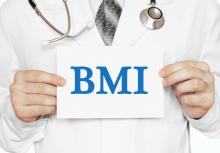A different measurement tool than body mass index (BMI) z scores was more accurate in assessing adolescents’ body fat percentage than BMI z scores, a study found.
More than twice as many adolescents aged 8-17 years were misclassified as overweight using BMI z scores than using triponderal mass index (TMI), which uses a formula for calculating a weight-to-height ratio, researchers reported. Obesity was similarly overreported with BMI z scores, compared with TMI scores.
“TMI requires only a single threshold for each sex, instead of the multiple complicated age- and sex-specific thresholds needed for BMI to work in adolescents,” reported Courtney M. Peterson, PhD, of the University of Alabama at Birmingham, and her associates.They suggest that TMI therefore may be superior to BMI or BMI z scores in assessing adolescents’ weight at least among non-Hispanic whites, although further studies would need to assess TMI as an assessment tool in other racial/ethnic groups.
The standard formula for adult BMI – weight in kilograms divided by height in meters squared – has been known to be inappropriate for children and teens for more than a century because their proportions change with age. The currently established alternative of using youth’s BMI percentiles for their age in the BMI z system, however, “fails to take into account that both body proportions and body fat levels change during adolescent growth in a way that is inconsistent with BMI,” the authors wrote (JAMA Pediatrics. 2017 May 15. doi: 10.1001/jamapediatrics.2017.0460).
They therefore explored other methods of assessing appropriate weight ranges for adolescents and compared them with BMI, using dual-energy x-ray absorptiometry findings and anthropometric data collected from 4,398 non-Hispanic white participants, aged 8-29 years, in U.S. National Health and Nutrition Examination Surveys (NHANES) from 1999 to 2006.
Dr. Peterson’s team first evaluated the value of using BMI by looking at the following:
• How percent body fat influences the timing of the adolescent growth spurt in height.
• How percent body fat varies by age.
• How body proportions scale during adolescence.
Then they explored changing the exponent in the weight-to-height formula to see which alternatives might result in a measurement that’s more stable with an individuals’ age, more accurate in estimating body fat percentage, and more accurate in identifying which youths are overweight.
“In girls and women, percent body fat increased with age and reached a plateau by age 18 years, rising from a mean of 31.2% at age 8-9 years to 36.4% at ages 25-29 years (P less than .001),” the authors wrote. “By contrast, in boys and men, percent body fat decreased from a mean of 27.8%-23.0% between ages 12-13 years and 14-15 years (P less than .001) before stabilizing at approximately 25%-26% for ages 20 years and older.”
Because variations in body fat percentage occurred with both age and height in adolescence, Dr. Peterson and her associates concluded that the usual BMI weight-to-height formula is not ideal for assessing body fat in youth. The better alternative, they found, uses the formula of weight divided by height cubed (instead of squared), called triponderal mass index (TMI).
The threshold for overweight status with TMI was 16.0 kg/m3 for boys and 16.8 kg/m3 for girls. For obesity, the threshold was 18.8 kg/m3 for boys and 19.7 kg/m3 for girls. Using TMI instead of BMI resulted in improved stability with age and estimated percent body fat for those aged 8-17 years.
In addition, using BMI z scores misclassified 19.4% of adolescents as overweight instead of a healthy weight whereas TMI only misclassified 8.4% of youth as such in the same data set. BMI z scores also classified more youth as obese (11.3%), compared with TMI (8%).
The research was funded by the National Center for Advancing Translational Sciences and the Eunice Kennedy Shriver National Institute of Child Health and Human Development. One investigator serves on the medical advisory boards for Medifast and Rice Lake Weighing System, unrelated to this study. Another investigator helped develop a trademarked smartphone weight loss intervention app called SmartLoss, whose licensing could benefit that investigator and Montclair State University.


